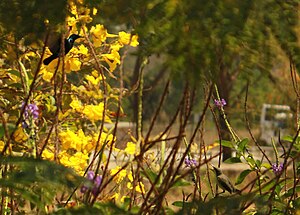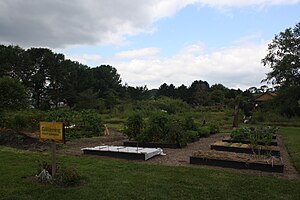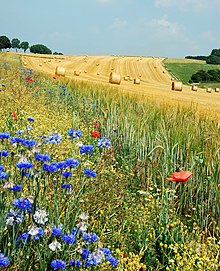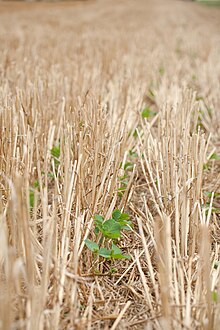Regenerative agriculture

Regenerative agriculture is a conservation and rehabilitation approach to food and farming systems. It focuses on topsoil regeneration, increasing biodiversity,[1] improving the water cycle,[2] enhancing ecosystem services, supporting biosequestration,[3] increasing resilience to climate change, and strengthening the health and vitality of farm soil.
Regenerative agriculture is not a specific practice itself. Rather, proponents of regenerative agriculture utilize a variety of other sustainable agriculture techniques in combination.[4] Practices include recycling as much farm waste as possible and adding composted material from sources outside the farm.[5][6][7][8] Regenerative agriculture on small farms and gardens is often based on philosophies like permaculture, agroecology, agroforestry, restoration ecology, keyline design, and holistic management. Large farms tend to be less philosophy driven and often use "no-till" and/or "reduced till" practices.
As soil health improves, input requirements may decrease, and crop yields may increase as soils are more resilient against extreme weather and harbor fewer pests and pathogens.[9]
Most plans to mitigate climate change focus on "reducing greenhouse gas emissions." Regenerative agriculture, i.e. the capture of atmospheric carbon dioxide by growing plants that move that carbon dioxide into the soil, is pretty nearly the only currently-functioning technology available for drawing down greenhouse gases that are already in the atmosphere, mostly through the cultivation and nurturing of forests and permanent perennial pastures and grasslands.

History[]

Origins[]
Regenerative agriculture is based on various agricultural and ecological practices, with a particular emphasis on minimal soil disturbance and the practice of composting.[10] Maynard Murray had similar ideas, using sea minerals.[11][12] His work led to innovations in no-till practices, such as slash and mulch in tropical regions.[13][14][15] Sheet mulching is a regenerative agriculture practice that smothers weeds and adds nutrients to the soil below.[16][17]

In the early 1980s, the Rodale Institute began using the term ‘regenerative agriculture’.[18] Rodale Publishing formed the Regenerative Agriculture Association, which began publishing regenerative agriculture books in 1987 and 1988.[19]
By marching forward under the banner of sustainability we are, in effect, continuing to hamper ourselves by not accepting a challenging enough goal. I am not against the word sustainable, rather I favor regenerative agriculture.
However, the institute stopped using the term in the late 1980s, and it only appeared sporadically (in 2005[20] and 2008), until they released a white paper in 2014, titled "Regenerative Organic Agriculture and Climate Change".[21] The paper's summary states, “we could sequester more than 100% of current annual CO2 emissions with a switch to common and inexpensive organic management practices, which we term 'regenerative organic agriculture.'” The paper described agricultural practices, like crop rotation, compost application, and reduced tillage,[21] that are similar to organic agriculture methods.

In 2002, Storm Cunningham documented the beginning of what he called "restorative agriculture" in his first book, The Restoration Economy. Cunningham defined restorative agriculture as, a technique that rebuilds the quantity and quality of topsoil, while also restoring local biodiversity (especially native pollinators) and watershed function. Restorative agriculture was one of the eight sectors of restorative development industries/disciplines in The Restoration Economy.[22]
Recent developments (since 2010)[]
While the term has existed for decades, regenerative agriculture has increasingly showed up in academic research since the early to mid 2010s in the fields of environmental science, plant science, and ecology.[23] As the term expands in use, many books have been published on the topic and several organizations started to promote regenerative agriculture techniques. Allan Savory gave a TED talk on fighting and reversing climate change in 2013. He also launched The Savory Institute, which educates ranchers on methods of holistic land management. Abe Collins created LandStream to monitor ecosystem performance in regenerative agriculture farms.[24] Eric Toensmeier had a book published on the subject in 2016.[25] However, researchers at Wageningen University in the Netherlands found there to be no consistent definition of what people referencing "regenerative agriculture" meant. They also found that most of the work around this topic were instead the authors' attempt at shaping what regenerative agriculture meant.[4]
Several large corporations have announced regenerative agriculture initiatives in the last few years. In 2019, General Mills announced an effort to promote regenerative agriculture practices in their supply chain and paid the non-profit Kiss the Ground to run educational events on regenerative agriculture in agricultural communities that support General Mills.[26] However, the effort has received criticism from academic and government experiments on sustainability in farming. In particular, Gunsmoke Farm partnered with General Mills to transition to regenerative agriculture practices and become a teaching hub for others. Experts from the area have expressed concerns about the farm now doing more harm than good, with agronomist Ruth Beck stating that "Environmental marketing got ahead of what farmers can actually do".[27]
In 2021, PepsiCo announced that by 2030 they will work with the farmers in their supply chain to establish regenerative agriculture practices across their approximately 7 million acres.[28][29] In 2021, Unilever announced an extensive implementation plan to incorporate regenerative agriculture throughout their supply chain.[30][31] VF Corporation, the parent company of The North Face, Timberland, and Vans, announced in 2021 a partnership with Terra Genesis International to create a supply chain for their rubber that comes from sources utilizing regenerative agriculture.[32][33] Nestle announced in 2021 a $1.8 billion investment in regenerative agriculture in an effort to reduce their emissions by 95%.[34]
Principles[]
There are several individuals, groups, and organizations that have attempted to define what the principles of regenerative agriculture are. In their review of the existing literature on regenerative agriculture, researchers at Wageningen University created a database of 279 published research articles on regenerative agriculture.[4] Their analysis of this database found that people using the term regenerative agriculture were using different principles to guide regenerative agriculture efforts.[4] The 4 most consistent principles were found to be, 1) enhancing and improving soil health, 2) optimization of resource management, 3) alleviation of climate change, and 4) improvement water quality and availability.
Notable Definitions of Principles[]
The organization The Carbon Underground created a set of principles that have been signed on to by a number of non-profits and corporations including Ben & Jerry's, Annie's, and the Rodale Institute, which was one of the first organization to use the term "Regenerative Agriculture" .[35] The principles they've outlined include building soil health and fertility, increase water percolation and retention, increasing biodiversity and ecosystem health, and reducing carbon emissions and current atmospheric CO2 levels.[35]
The group Terra Genesis International based in Thailand, and VF Corporation's partner in their regenerative agriculture initiative, created a set of 4 principles, which include:[36][5]
- "Progressively improve whole agroecosystems (soil, water and biodiversity)"
- "Create context-specific designs and make holistic decisions that express the essence of each farm"
- "Ensure and develop just and reciprocal relationships amongst all stakeholders"
- "Continually grow and evolve individuals, farms, and communities to express their innate potential"
Practices[]
Practices include but are not limited to:[7][5][37][38]
- Permaculture design
- Aquaculture[39]
- Agroecology[39]
- Agroforestry[5]
- Soil food web
- Livestock: well-managed grazing,[7] animal integration[5] and holistically managed grazing[5]
- Keyline subsoiling
- Conservation farming, no-till farming, minimum tillage,[7] and pasture cropping[5]
- Cover crops & multi-species cover crops[7]
- Organic annual cropping[5] and crop rotations[7]
- Compost, compost tea,[5] animal manures[7] and thermal compost
- Natural sequence farming
- Grassfed livestock
- Polyculture and full-time succession planting of multiple and inter-crop plantings[7]
- Borders planted for pollinator habitat and other beneficial insects[7]
- Biochar/terra preta[5]
- Ecological aquaculture[5]
- Perennial crops[5]
- Silvopasture[5]
- Alternative food networks (AFNs), commonly defined by attributes such as the spatial proximity between farmers and consumers.[40]
- Home gardens, to mitigate the adverse effect of global food shocks and food price volatilities. Consequently, there is much attention towards home gardens as a strategy to enhance household food security and nutrition.[41]
- Regrowing vegetables, for recycling and sustainable living.[42]
Environmental Impacts[]
Carbon Sequestration[]
Conventional agricultural practices such as plowing and tilling release carbon dioxide (CO2) from the soil by exposing organic matter to the surface and thus promoting oxidation.[43] It is estimated that roughly a third of the total anthropogenic inputs of CO2 to the atmosphere since the industrial revolution have come from the degradation of soil organic matter[43] and that 30-75% of global soil organic matter has been lost since the advent of tillage-based farming.[44] Greenhouse gas (GHG) emissions associated with conventional soil and cropping activities represent 13.7% of anthropogenic emissions, or 1.86 Pg-C y−1.[44] The raising of ruminant livestock also contributes GHGs, representing 11.6% of anthropogenic emissions, or 1.58 Pg-C y−1.[44] Furthermore, runoff and siltation of water bodies associated with conventional farming practices promote eutrophication and emissions of methane.[44]
Regenerative agriculture practices such as no-till farming, rotational grazing, mixed crop rotation, cover cropping, and the application of compost and manure have the potential to reverse this trend. No-till farming reintroduces carbon back into the soil as crop residues are pressed down when seeding. Some studies suggest that adoption of no-till practices could triple soil carbon content in less than 15 years.[43] Additionally, 1 Pg-C y−1, representing roughly a fourth to a third of anthropogenic CO2 emissions,[45] may be sequestered by converting croplands to no-till systems on a global scale.[43]
Regenerative grazing management, particularly adaptive multipaddock (AMP) grazing, has been shown to reduce soil degradation compared to continuous grazing and thus has the potential to mitigate carbon emissions from soil.[44] Crop rotation and maintenance of permanent cover crops help to reduce soil erosion as well, and in conjunction with AMP grazing, may result in net carbon sequestration.[44] One study suggests that total conversion of livestock raising to AMP grazing practices coupled with conservation cropping has the potential to convert North American farmlands to a carbon sink, sequestering approximately 1.2 Pg-C y−1.[44] Over the next 25–50 years, the cumulative sequestration potential is 30-60 Pg-C. Additions of organic manures and compost further build soil organic carbon, thus contributing to carbon sequestration potential.[45]
Nutrient Cycling[]
Soil organic matter is the primary sink of nutrients necessary for plant growth such as nitrogen, phosphorus, zinc, sulfur, and molybdenum.[45] Conventional tillage-based farming promotes rapid erosion and degradation of soil organic matter, depleting soil of plant nutrients and thus lowering productivity.[43] Tillage, in conjunction with additions of inorganic fertilizer, also destroys soil microbial communities, reducing production of organic nutrients in soil.[43] Practices that restore organic matter may be used to increase the total nutrient load of soil.[45] For example, regenerative management of ruminant livestock in mixed-crop and grazing agroecosystems has been shown to improve soil nutrient cycling by encouraging the consumption and decomposition of residual crop biomass and promoting the recovery of nitrogen-fixing plant species.[44] Regenerative crop management practices, namely the use of crop rotation to ensure permanent ground cover, have the potential to increase soil fertility and nutrient levels if nitrogen-fixing crops are included in the rotation.[44] Crop rotation and rotational grazing also allow the nutrients in soil to recover between growing and grazing periods, thus further enhancing overall nutrient load and cycling.[45]
Biodiversity[]
Conventional agricultural practices are generally understood to simplify agroecosystems through introduction of monocultures and eradication of diversity in soil microbial communities through chemical fertilization.[46] In natural ecosystems, biodiversity serves to regulate ecosystem function internally, but under conventional agricultural systems, such control is lost and requires increasing levels of external, anthropogenic input.[46] By contrast, regenerative agriculture practices including polycultures, mixed crop rotation, cover cropping, organic soil management, and low- or no-tillage methods have been shown to increase overall species diversity while reducing pest population densities.[46] Additionally, practices that favor organic over inorganic inputs aid in restoring below-ground biodiversity by enhancing the functioning of soil microbial communities.[45] A survey of organic and conventional farms in Europe found that on the whole, species across several taxa were higher in richness and/or abundance on organic farms compared to conventional ones, especially species whose populations have been demonstrably harmed as a direct result of conventional agriculture.[47]
AMP grazing can help improve biodiversity since increased soil organic carbon stocks also promotes a diversity of soil microbial communities.[44] Implementation of AMP in North American prairies, for example, has been correlated with an increase in forage productivity and the restoration of plant species that had previously been decimated by continuous grazing practices.[44] Furthermore, studies of arid and semiarid regions of the world where regenerative grazing has been practiced for a long time following prior periods of continuous grazing have shown a recovery of biodiversity, grass species, and pollinator species.[44]
Policy and Politics[]
The examples and perspective in this section may not represent a worldwide view of the subject. (May 2021) |
In February 2021, the regenerative agriculture market gained traction after Joe Biden's Secretary of Agriculture Tom Vilsack made reference to it during his Senate Confirmation hearing. The Biden Administration wants to utilize $30 billion from the USDA's Commodity Credit Corporations to incentive farmers to adopt sustainable practices.[48] Vilsack stated in the hearing, "It is a great tool for us to create the kind of structure that will inform future farm bills about what will encourage carbon sequestration, what will encourage precision agriculture, what will encourage soil health and regenerative agricultural practices."[49] After this announcement from the Biden Administration, several national and international corporations announced initiatives into regenerative agriculture.[32][30][29]
During the House of Representatives Committee on Agriculture's first hearing on climate change, Gabe Brown, a proponent of regenerative agriculture, testified about the role of regenerative agriculture in both the economics and sustainability of farming.[50]
Criticism[]
Some members of the scientific community have criticized as exaggerated and unsupported by evidence some of the claims made by proponents of regenerative agriculture.[51]
One of the prominent proponents of regenerative agriculture, Allan Savory, claimed in his TED talk that holistic grazing could reduce carbon-dioxide levels to pre-industrial levels in a span of 40 years. According to Skeptical Science:
"it is not possible to increase productivity, increase numbers of cattle and store carbon using any grazing strategy, never-mind Holistic Management [...] Long term studies on the effect of grazing on soil carbon storage have been done before, and the results are not promising.[...] Because of the complex nature of carbon storage in soils, increasing global temperature, risk of desertification and methane emissions from livestock, it is unlikely that Holistic Management, or any management technique, can reverse climate change.[52]"
According to a 2016 study published by the Swedish University of Agricultural Sciences, the actual rate at which improved grazing management could contribute to carbon sequestration is seven times lower than the claims made by Savory. The study concludes that holistic management cannot reverse climate change.[53] A study by the Food and Climate Research Network in 2017 concluded that Savory's claims about carbon sequestration are "unrealistic" and very different from those issued by peer-reviewed studies.[51]
Tim Searchinger and Janet Ranganathan have expressed concerns about emphasis upon "Practices That Increase Soil Carbon at the Field Level" because "overestimating potential soil carbon gains could undermine efforts to advance effective climate mitigation in the agriculture sector." Instead Tim Searchinger and Janet Ranganathan say, "preserving the huge, existing reservoirs of vegetative and soil carbon in the world’s remaining forests and woody savannas by boosting productivity on existing agricultural land (a land sparing strategy) is the largest, potential climate mitigation prize of regenerative and other agricultural practices. Realizing these benefits requires implementing practices in ways that boost productivity and then linking those gains to governance and finance to protect natural ecosystems. In short, produce, protect and prosper are the most important opportunities for agriculture."[54]
See also[]
- Agroecological restoration
- Agroecology
- Agroforestry
- Biointensive agriculture
- Carbon farming
- Farmer-managed natural regeneration
- Korean natural farming
- Permaculture
- Regenerative Design
External links[]
- Learning from Nature
- Kiss the Ground at IMDb
- VicNoTill at Horsham, Victoria. No-Till Regenerative Farming Systems Australia.
References[]
- ^ "Our Sustainable Future - Regenerative Ag Description". csuchico.edu. Retrieved 2017-03-09.
- ^ Underground, The Carbon; Initiative, Regenerative Agriculture; CSU (2017-02-24). "What is Regenerative Agriculture?". Regeneration International. Retrieved 2017-03-09.
- ^ Teague, W. R.; Apfelbaum, S.; Lal, R.; Kreuter, U. P.; Rowntree, J.; Davies, C. A.; Conser, R.; Rasmussen, M.; Hatfield, J.; Wang, T.; Wang, F. (2016-03-01). "The role of ruminants in reducing agriculture's carbon footprint in North America". Journal of Soil and Water Conservation. 71 (2): 156–164. doi:10.2489/jswc.71.2.156. ISSN 0022-4561.
- ^ Jump up to: a b c d Schreefel, L.; Schulte, R.P.O.; De Boer, I.J.M.; Schrijver, A. Pas; Van Zanten, H.H.E. (2020-09-01). "Regenerative agriculture – the soil is the base". Global Food Security. 26: 100404. doi:10.1016/j.gfs.2020.100404. ISSN 2211-9124.
- ^ Jump up to: a b c d e f g h i j k l m "Regenerative Agriculture". regenerativeagriculturedefinition.com. Retrieved 2017-03-07.
- ^ "Regenerative Agriculture". Regenerative Agriculture Foundation. Retrieved 2017-03-09.
- ^ Jump up to: a b c d e f g h i "Definition — The Carbon Underground : The Carbon Underground". thecarbonunderground.org. Retrieved 2017-03-07.
- ^ "Regenerative Organic Agriculture | ORGANIC INDIA". us.organicindia.com. Retrieved 2017-03-09.
- ^ Moebius-Clune, B. N. (2016). "Comprehensive Assessment of Soil Health – The Cornell Framework (Version 3.2)". Cornell University, Cornell Soil Health Laboratory (Edition 3.2 ed.). Retrieved 2021-04-17.
- ^ Hensel, Julius (1917). Bread from stones : a new and rational system of land fertilization and physical regeneration. Planet Pub. House. ISBN 0-665-79105-4. OCLC 1083992856. Republished by Acres USA, Austin, Texas, 1991
- ^ Murray, Maynard. (2003). Sea energy agriculture. Acres U.S.A. ISBN 0-911311-70-X. OCLC 52379170. (originally published 1976).
- ^ Phil, Nauta. (2012). Building soils naturally - innovative methods for organic gardeners. ISBN 978-1-60173-033-6. OCLC 1023314099.
- ^ Fukuoka, Masanobu. (2010). The one-straw revolution : an introduction to natural farming. New York Review Books. ISBN 978-1-59017-392-3. OCLC 681750905. and Fukuoka, Masanobu Metreaud, Frederic P. (1993). The natural way of farming : the theory and practice of green philosophy. Bookventure. ISBN 978-81-85987-00-2. OCLC 870936183.CS1 maint: multiple names: authors list (link)
- ^ Hamaker, John D. (1982). The survival of civilization depends upon our solving three problems--carbon dioxide, investment money, and population : selected papers of John D. Hamaker. Hamaker-Weaver Publishers. OCLC 950891698.
- ^ Whatley, Booker T. How to Make $100,000 Farming 25 Acres. Emmaus, Pennsylvania, Regenerative Agriculture Association, 1987. 180 pages.
- ^ Lanza, Patricia. (1998). Lasagna gardening: A new Layering System for bountiful gardens: no digging, no tilling, no weeding, no kidding. Emmaus, PA. ISBN 978-0-87596-795-0. OCLC 733752184.
- ^ Holzer, Sepp. (2011). Sepp Holzer's permaculture : a practical guide to small-scale, integrative farming and gardening. Chelsea Green Publishing. ISBN 978-1-60358-370-1. OCLC 1120375143.
- ^ "AFSIC History Timeline". Alternative Farming Systems Information Center, United States National Agricultural Library, USDA. Retrieved 2017-03-09.
- ^ "Tracing the Evolution of Organic / Sustainable Agriculture (TESA1980) | Alternative Farming Systems Information Center| NAL | USDA". Retrieved 2017-03-09.
- ^ "A truly regenerative agriculture". Rodale Institute. 7 January 2005. Retrieved 2017-03-09.
- ^ Jump up to: a b "Regenerative Organic Agriculture and Climate Change". Rodale Institute. Retrieved 2017-03-09.
- ^ Cunningham, Storm. The Restoration Economy. Berrett-Koehler Publishers, 2002. 340p.
- ^ "Web of Science - Please Sign In to Access Web of Science". login.webofknowledge.com. Retrieved 2021-03-06.
- ^ Collins, Abe. "Growing Deep Soil Watersheds" (PDF). Harvard Forest. Retrieved 2019-08-19.
- ^ "Book Review: The Carbon Farming Solution". Ecological Landscape Alliance. 2017-01-15. Retrieved 2021-05-07.
- ^ Anzilotti, Eillie (2019-03-04). "General Mills has a plan to regenerate 1 million acres of farmland". Fast Company. Retrieved 2021-05-07.
- ^ "A Giant Organic Farm Faces Criticism That It's Harming The Environment". NPR.org. Retrieved 2021-05-07.
- ^ Peters, Adele (2021-04-20). "PepsiCo is scaling up regenerative agriculture on 7 million acres of land". Fast Company. Retrieved 2021-05-07.
- ^ Jump up to: a b "PepsiCo announces 2030 goal to scale regenerative farming practices across 7 million acres". Successful Farming. 2021-04-20. Retrieved 2021-05-07.
- ^ Jump up to: a b "Unilever Bets (Part of) the Farm on Regenerative Agriculture". www.triplepundit.com. Retrieved 2021-05-07.
- ^ "How we will grow our ingredients in harmony with nature". Unilever global company website. Retrieved 2021-05-07.
- ^ Jump up to: a b "Timberland, Vans, The North Face to develop regenerative rubber supply chain". edie.net. Retrieved 2021-05-07.
- ^ "Regenerative Agriculture, Coming Soon to a Timberland Shoe Near You". www.triplepundit.com. Retrieved 2021-05-07.
- ^ "$3.5 billion net-zero plan at Nestle gets shareholder approval". Fortune. Retrieved 2021-05-07.
- ^ Jump up to: a b "Regenerative Agriculture Definition". The Carbon Underground. Retrieved 2021-05-07.
- ^ Soloviev, E. and Landua, G. Levels of Regenerative Agriculture. Terra Genesis International, High Falls, NY, 2016.
- ^ "The 9 Most Important Techniques In Regenerative Agriculture |". Archived from the original on 2017-03-08. Retrieved 2017-03-07.
- ^ Chapman, Glen (2018-08-21). "Regenerative Techniques and Tools". Southern Blue Regenerative. Retrieved 2019-09-23.
- ^ Jump up to: a b "Why Regenerative Agriculture?". Regeneration International. Retrieved 2020-02-04.
- ^ Jarosz, Lucy (2008-07-01). "The city in the country: Growing alternative food networks in Metropolitan areas". Journal of Rural Studies. 24 (3): 231–244. doi:10.1016/j.jrurstud.2007.10.002. ISSN 0743-0167.
- ^ Galhena, Dilrukshi Hashini; Freed, Russell; Maredia, Karim M. (2013-05-31). "Home gardens: a promising approach to enhance household food security and wellbeing". Agriculture & Food Security. 2 (1): 8. doi:10.1186/2048-7010-2-8. ISSN 2048-7010.
- ^ Raupach, Melissa; Lill, Felix (2020). Regrow Your Veggies: Growing Vegetables from Roots, Cuttings and Scraps. CompanionHouse Books. ISBN 9798566983134.
- ^ Jump up to: a b c d e f Montgomery, David R. (2007). "Is agriculture eroding civilization's foundation?". GSA Today. 17 (10): 4. doi:10.1130/gsat01710a.1. ISSN 1052-5173.
- ^ Jump up to: a b c d e f g h i j k l Teague, W. R.; Apfelbaum, S.; Lal, R.; Kreuter, U. P.; Rowntree, J.; Davies, C. A.; Conser, R.; Rasmussen, M.; Hatfield, J.; Wang, T.; Wang, F. (2016-03-01). "The role of ruminants in reducing agriculture's carbon footprint in North America". Journal of Soil and Water Conservation. 71 (2): 156–164. doi:10.2489/jswc.71.2.156. ISSN 0022-4561.
- ^ Jump up to: a b c d e f Lal, R. (2004-11-01). "Soil carbon sequestration to mitigate climate change". Geoderma. 123 (1–2): 1–22. Bibcode:2004Geode.123....1L. doi:10.1016/j.geoderma.2004.01.032. ISSN 0016-7061.
- ^ Jump up to: a b c Altieri, Miguel A. (June 1999). "The ecological role of biodiversity in agroecosystems". Agriculture, Ecosystems and Environment. 74 (1–3): 19–31. doi:10.1016/S0167-8809(99)00028-6.
- ^ Hole, D.G.; Perkins, A.J.; Wilson, J.D.; Alexander, I.H.; Grice, P.V.; Evans, A.D. (2005-03-01). "Does organic farming benefit biodiversity?". Biological Conservation. 122 (1): 113–130. doi:10.1016/j.biocon.2004.07.018. ISSN 0006-3207.
- ^ Newburger, Emma (2021-02-12). "Biden's climate change strategy looks to pay farmers to curb carbon footprint". CNBC. Retrieved 2021-03-06.
- ^ "Agriculture Secretary Confirmation Hearing | C-SPAN.org". www.c-span.org. Retrieved 2021-03-06.
- ^ Latzke, Jennifer M. "House Ag Committee hears how agriculture may play role in mitigating climate change". High Plains Journal. Retrieved 2021-03-06.
- ^ Jump up to: a b
Garnett, Tara; Godde, Cécile (2017). "Grazed and confused?" (PDF). Food Climate Research Network. p. 64. Retrieved 11 February 2021.
The non-peer-reviewed estimates from the Savory Institute are strikingly higher – and, for all the reasons discussed earlier (Section 3.4.3), unrealistic.
- ^ "New rebuttal to the myth 'Holistic Management can reverse Climate Change'". Skeptical Science.
- ^ Nordborg, M. (2016). Holistic management – a critical review of Allan Savory's grazing method. Uppsala: SLU/EPOK – Centre for Organic Food & Farming & Chalmers.
- ^ Searchinger, Tim; Ranganathan, Janet (August 24, 2020). "Further Explanation on the Potential Contribution of Soil Carbon Sequestration on Working Agricultural Lands to Climate Change Mitigation". World Resources Institute.
- Agroecology
- Organic farming
- Permaculture
- Permaculture concepts
- Climate change and agriculture